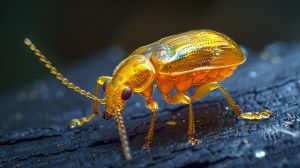Emberfly
The emberfly (Igniluma vignivolans) is a species of beetle known for its unique magical properties and heat-resistant capabilities. Despite its small size, only about 1 millimeter in length, the emberfly has gained attention for its role in magical potion-making and its fascinating behavior, particularly during mating seasons when they seek out fires. Found primarily in forested regions, emberflies play a subtle but important role in their ecosystems, while also inspiring fireproofing potions through the study of their biology.
Appearance
Emberflies are diminutive beetles, typically around 1 millimeter long, with a glossy carapace that can glow a red or orange hue when exposed to extreme heat. Their exoskeleton is impervious to fire, which allows them to fly into open flames and emerge without harm. This glowing appearance often makes them indistinguishable from embers, especially when they take flight during their mating behavior. Their bodies are covered in tiny, intricate patterns, and they possess long, segmented antennae that help them detect heat sources from afar.
Habitat
Emberflies primarily inhabit forested areas that are prone to wildfires, where they live underground, close to tree roots. Their primary food source is the beneficial mycelium that grows around the roots of trees. The emberflies' diet doesn't harm the trees, as their size and the amount they consume are too small to cause significant damage. However, their activity can contribute to the health of forest ecosystems by interacting with fungal networks and participating in the natural cycles of the forest floor.
Their attraction to fire becomes more pronounced during the mating season, when they seek out areas affected by forest fires, although they have also been observed around campfires and bonfires. While the majority of the population lives deep within the forest, smaller groups may venture near human habitation if fire or artificial light sources attract them.
Mating Behaviour
One of the most fascinating aspects of the emberfly is its mating behavior, which is triggered primarily by forest fires. During these events, the emberflies fly into the fire, allowing their bodies to heat up and glow like embers. They will then fly into the air, mimicking the movement of actual embers. This behavior is believed to be a form of mimicry, making it difficult for predators—or even potential mates—to distinguish between embers and the beetles themselves. How the emberflies differentiate between actual embers and potential mates remains unclear, but their behavior seems to be driven by instinctual responses to heat and light.
Mating can also occur around smaller fires, such as campfires, although these events typically attract smaller groups of emberflies. Once mating is triggered, the emberflies fly in erratic patterns above the flames, before eventually dispersing to lay eggs in the surrounding soil.
Uses in Magic
Though the emberflies are too small to be used directly in magical spells or potions, philtromancers have studied their heat resistance extensively. By mimicking the natural properties of their fireproof exoskeleton, philtromantists have developed the most popular form of fireproofing potions used by both wizards and non-magical individuals alike. These potions replicate the emberflies' biological defenses against heat and flame, offering protection in high-temperature environments or during magical rituals involving fire.
Conservational Status:
Despite their unique behavior and magical associations, emberflies are classified as a species of Least Concern. Due to their small size and underground habitat, they are not significantly affected by human activity or environmental changes. They remain plentiful in their natural environments, and their population numbers have not shown any significant decline.
While emberflies are sometimes blamed for damaging artificial light sources by inadvertently flying into bulbs or other heated equipment, this does not pose any major threat to their overall population. Conservation efforts are not currently necessary, though their role in the ecosystem as fungal grazers and fire mimics is still being studied to ensure they remain an important part of forest ecology.
